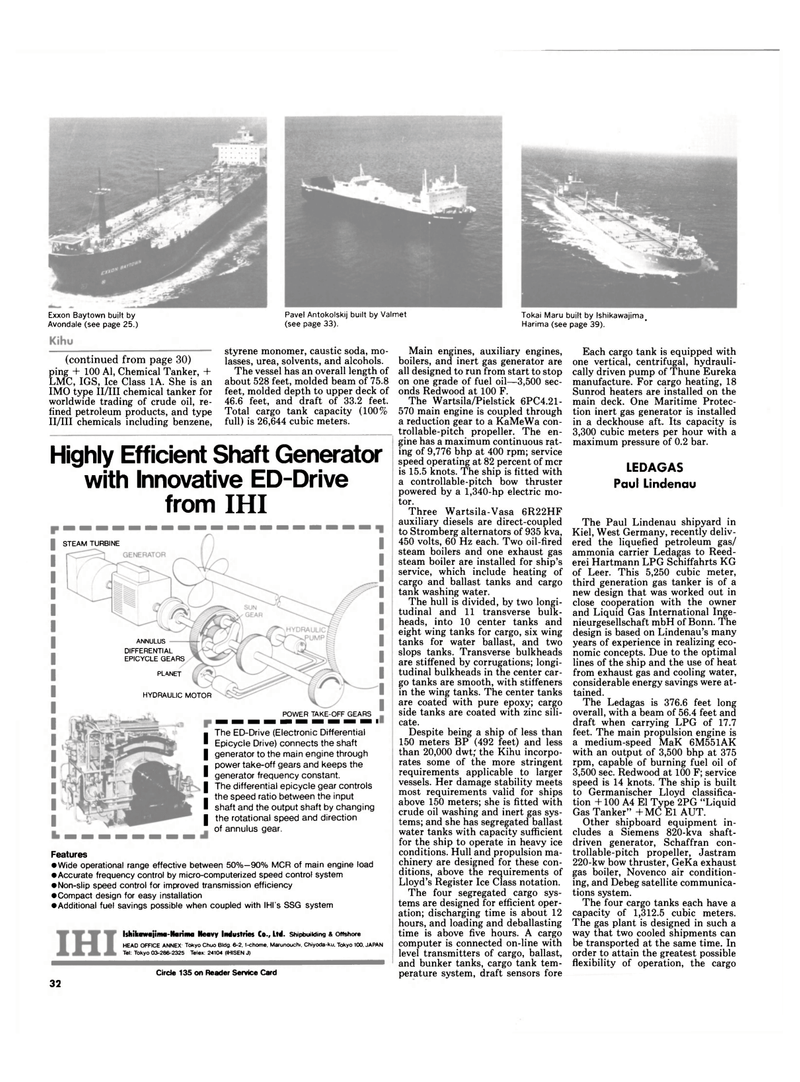
Page 30: of Maritime Reporter Magazine (December 1984)
Read this page in Pdf, Flash or Html5 edition of December 1984 Maritime Reporter Magazine
(continued from page 30) ping + 100 Al, Chemical Tanker, +
LMC, IGS, Ice Class 1A. She is an
IMO type II/III chemical tanker for worldwide trading of crude oil, re- fined petroleum products, and type
II/III chemicals including benzene, styrene monomer, caustic soda, mo- lasses, urea, solvents, and alcobols.
The vessel has an overall length of about 528 feet, molded beam of 75.8 feet, molded depth to upper deck of 46.6 feet, and draft of 33.2 feet.
Total cargo tank capacity (100% full) is 26,644 cubic meters.
Main engines, auxiliary engines, boilers, and inert gas generator are all designed to run from start to stop on one grade of fuel oil—3,500 sec- onds Redwood at 100 F.
The Wartsila/Pielstick 6PC4.21- 570 main engine is coupled through a reduction gear to a KaMeWa con- trollable-pitch propeller. The en- gine has a maximum continuous rat- ing of 9,776 bhp at 400 rpm; service speed operating at 82 percent of mcr is 15.5 knots. The ship is fitted with a controllable-pitch bow thruster powered by a 1,340-hp electric mo- tor.
Three Wartsila-Vasa 6R22HF auxiliary diesels are direct-coupled to Stromberg alternators of 935 kva, 450 volts, 60 Hz each. Two oil-fired steam boilers and one exhaust gas steam boiler are installed for ship's service, which include heating of cargo and ballast tanks and cargo tank washing water.
The hull is divided, by two longi- tudinal and 11 transverse bulk- heads, into 10 center tanks and eight wing tanks for cargo, six wing tanks for water ballast, and two slops tanks. Transverse bulkheads are stiffened by corrugations; longi- tudinal bulkheads in the center car- go tanks are smooth, with stiffeners in the wing tanks. The center tanks are coated with pure epoxy; cargo side tanks are coated with zinc sili- cate.
Despite being a ship of less than 150 meters BP (492 feet) and less than 20,000 dwt; the Kihu incorpo- rates some of the more stringent requirements applicable to larger vessels. Her damage stability meets most requirements valid for ships above 150 meters; she is fitted with crude oil washing and inert gas sys- tems; and she has segregated ballast water tanks with capacity sufficient for the ship to operate in heavy ice conditions. Hull and propulsion ma- chinery are designed for these con- ditions, above the requirements of
Lloyd's Register Ice Class notation.
The four segregated cargo sys- tems are designed for efficient oper- ation; discharging time is about 12 hours, and loading and deballasting time is above five hours. A cargo computer is connected on-line with level transmitters of cargo, ballast, and bunker tanks, cargo tank tem- perature system, draft sensors fore
Each cargo tank is equipped with one vertical, centrifugal, hydrauli- cally driven pump of Thune Eureka manufacture. For cargo heating, 18
Sunrod heaters are installed on the main deck. One Maritime Protec- tion inert gas generator is installed in a deckhouse aft. Its capacity is 3,300 cubic meters per hour with a maximum pressure of 0.2 bar.
LEDAGAS
Paul Lindenau
The Paul Lindenau shipyard in
Kiel, West Germany, recently deliv- ered the liquefied petroleum gas/ ammonia carrier Ledagas to Reed- erei Hartmann LPG Schiffahrts KG of Leer. This 5,250 cubic meter, third generation gas tanker is of a new design that was worked out in close cooperation with the owner and Liquid Gas International Inge- nieurgesellschaft mbH of Bonn. The design is based on Lindenau's many years of experience in realizing eco- nomic concepts. Due to the optimal lines of the ship and the use of heat from exhaust gas and cooling water, considerable energy savings were at- tained.
The Ledagas is 376.6 feet long overall, with a beam of 56.4 feet and draft when carrying LPG of 17.7 feet. The main propulsion engine is a medium-speed MaK 6M551AK with an output of 3,500 bhp at 375 rpm, capable of burning fuel oil of 3,500 sec. Redwood at 100 F; service speed is 14 knots. The ship is built to Germanischer Lloyd classifica- tion + 100 A4 El Type 2PG "Liquid
Gas Tanker" +MC El AUT.
Other shipboard equipment in- cludes a Siemens 820-kva shaft- driven generator, Schaffran con- trollable-pitch propeller, Jastram 220-kw bow thruster, GeKa exhaust gas boiler, Novenco air condition- ing, and Debeg satellite communica- tions system.
The four cargo tanks each have a capacity of 1,312.5 cubic meters.
The gas plant is designed in such a way that two cooled shipments can be transported at the same time. In order to attain the greatest possible flexibility of operation, the cargo
Highly Efficient Shaft Generator with Innovative ED-Drive from IHI
Features • Wide operational range effective between 50%—90% MCR of main engine load • Accurate frequency control by micro-computerized speed control system • Non-slip speed control for improved transmission efficiency • Compact design for easy installation • Additional fuel savings possible when coupled with IHI's SSG system
Ishikawaiima-HarinMi Heavy Industries Co., Ltd. Shipbuilding & onshore
HEAD OFFICE ANNEX: Tokyo Chuo Bldg. 6-2, 1-chome, Marunouchi. Chiyoda-ku, Tokyo 100. JAPAN
Tel: Tokyo 03-286-2325 Telex: 24104 (IHISEN J)
Circle 135 on Reader Service Card 32
Exxon Baytown built by
Avondale (see page 25.)
Pavel Antokolskij built by Valmet (see page 33).
Tokai Maru built by lshikawajimat
Harima (see page 39).
STEAM TURBINE
ANNULUS
DIFFERENTIAL
EPICYCLE GEARS
PLANET
HYDRAULIC MOTOR
POWER TAKE-OFF GEARS mm mm mm • mm mm mm hi •• mm •
The ED-Drive (Electronic Differential
Epicycle Drive) connects the shaft generator to the main engine through power take-off gears and keeps the generator frequency constant.
The differential epicycle gear controls the speed ratio between the input shaft and the output shaft by changing the rotational speed and direction of annulus gear.
I
I
I
I
I
I

 29
29

 31
31
